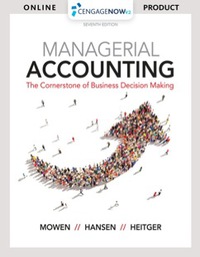

7-34 Departmental Cost Allocation; Outsourcing Marin Company produces two software products (Cloud-X and Cloud-Y) in two separate departments (A and B). These products are highly regarded network maintenance programs. Cloud-X is used for small networks and Cloud-Y is used for large networks. Marin is known for the quality of its products and its ability to meet dates promised for software upgrades. Department A produces Cloud-X, and department B produces Cloud-Y. The production departments are supported by two support departments, systems design and programming services. The sources and uses of the support department time are summarized as follows: Total Labor Hours From Design Programming Department A Department B Design 5,000 1.000 9,000 Programming 400 600 1,000 15,000 2.000 The costs in the two service departments are as follows: Design Programming Labor and materials (all variable) $50,000 $36.000 Depreciation and other fixed costs 40,000 4,000 Total $90,000 $40.000 7-35 Departmental Cost Allocation Logan Products has two production departmentsassembly and finishing. Page 259 These are supported by two service departmentssourcing (purchasing and handling of materials and human resources) and operations (work scheduling, supervision, and inspection). Logan has the following labor hours devoted by each of the service departments to the other departments. Total Labor Hours Used by Departments Sourcing Operations Assembly Finishing Sourcing 20.000 40,000 60,000 Operations 10.000 60,000 50,000 The costs incurred in the plant are as follows: Departments Departmental Costs Sourcing $165,000 Operations 205,000 Assembly 410,000 Finishing 255,000 Total $1,035,000 Required Use four decimal places (e.g., 33.3333%) in your calculation of percentages. 1. What are the costs allocated to the two production departments using (a) the direct method, (b) the step method, when the sourcing department that provides the greatest percentage of services to other service departments goes first), and (c) the reciprocal method? 2. What are the total costs in the production departments after allocation? [LO 7-3.7-4) 7-34 Departmental Cost Allocation; Outsourcing Marin Company produces two software products (Cloud-X and Cloud-Y) in two separate departments (A and B). These products are highly regarded network maintenance programs. Cloud-X is used for small networks and Cloud-Y is used for large networks. Marin is known for the quality of its products and its ability to meet dates promised for software upgrades. Department A produces Cloud-X, and department B produces Cloud-Y. The production departments are supported by two support departments, systems design and programming services. The sources and uses of the support department time are summarized as follows: Total Labor Hours From Design Programming Department A Department B Design 5,000 1.000 9,000 Programming 400 600 1,000 15,000 2.000 The costs in the two service departments are as follows: Design Programming Labor and materials (all variable) $50,000 $36.000 Depreciation and other fixed costs 40,000 4,000 Total $90,000 $40.000 7-35 Departmental Cost Allocation Logan Products has two production departmentsassembly and finishing. Page 259 These are supported by two service departmentssourcing (purchasing and handling of materials and human resources) and operations (work scheduling, supervision, and inspection). Logan has the following labor hours devoted by each of the service departments to the other departments. Total Labor Hours Used by Departments Sourcing Operations Assembly Finishing Sourcing 20.000 40,000 60,000 Operations 10.000 60,000 50,000 The costs incurred in the plant are as follows: Departments Departmental Costs Sourcing $165,000 Operations 205,000 Assembly 410,000 Finishing 255,000 Total $1,035,000 Required Use four decimal places (e.g., 33.3333%) in your calculation of percentages. 1. What are the costs allocated to the two production departments using (a) the direct method, (b) the step method, when the sourcing department that provides the greatest percentage of services to other service departments goes first), and (c) the reciprocal method? 2. What are the total costs in the production departments after allocation? [LO 7-3.7-4)








